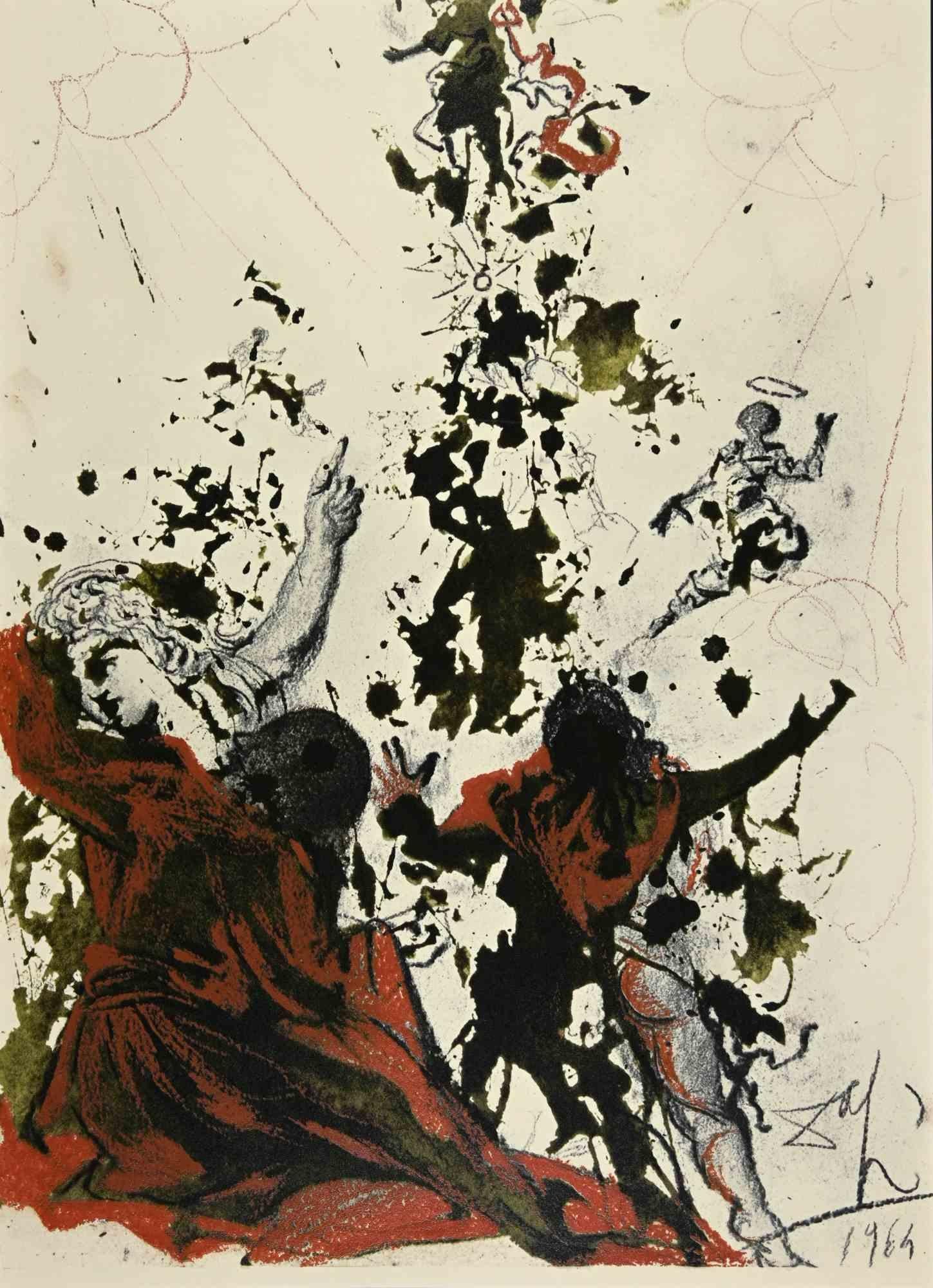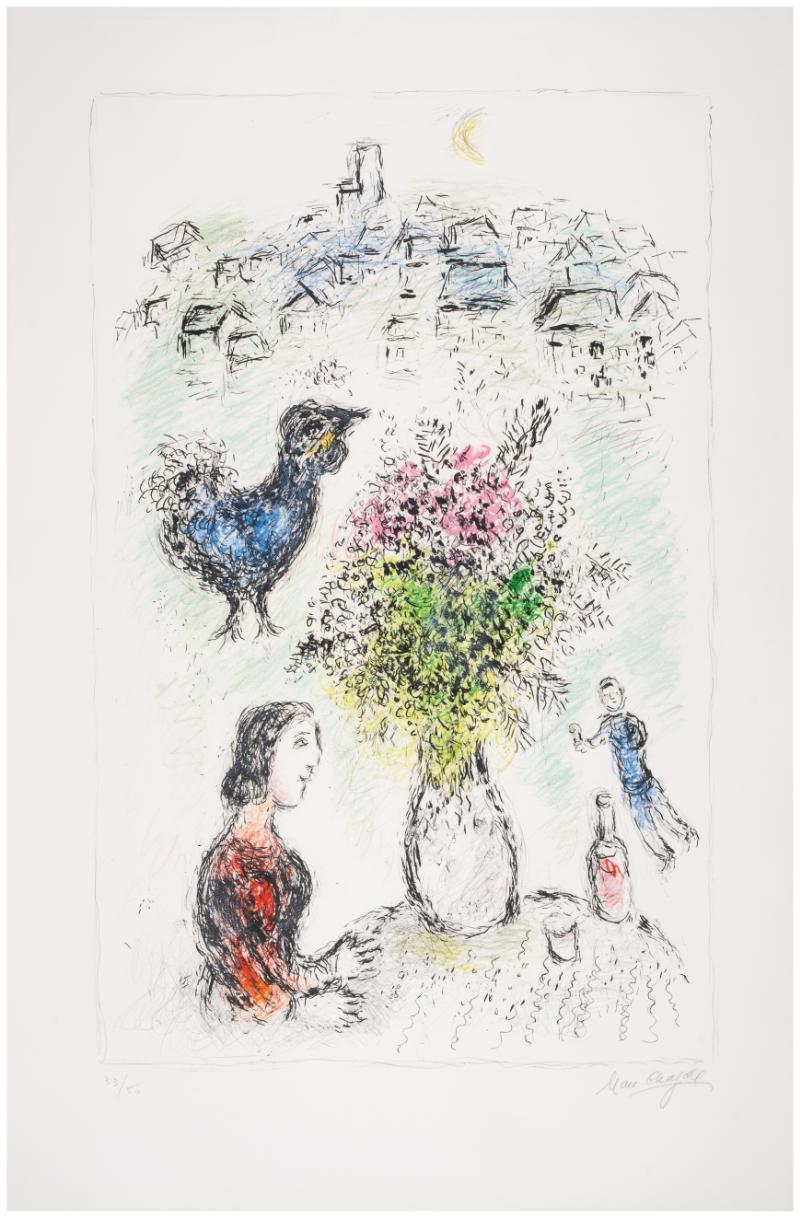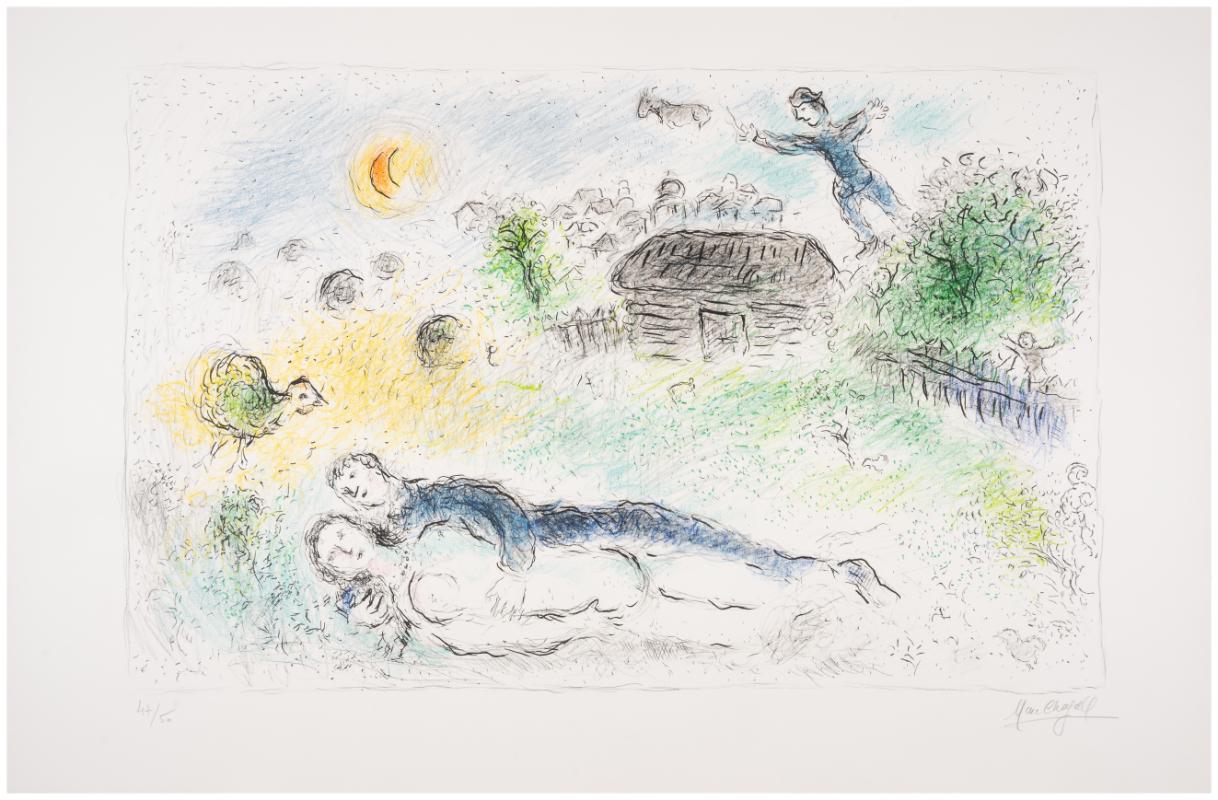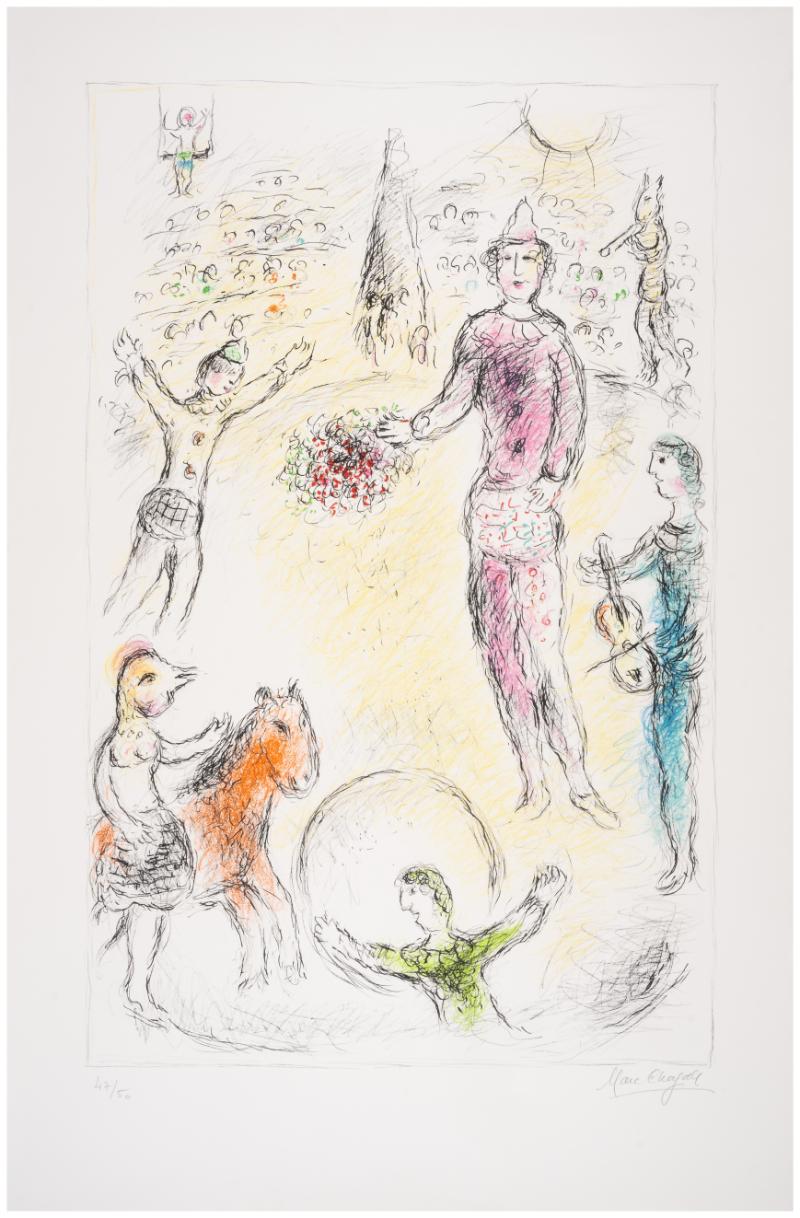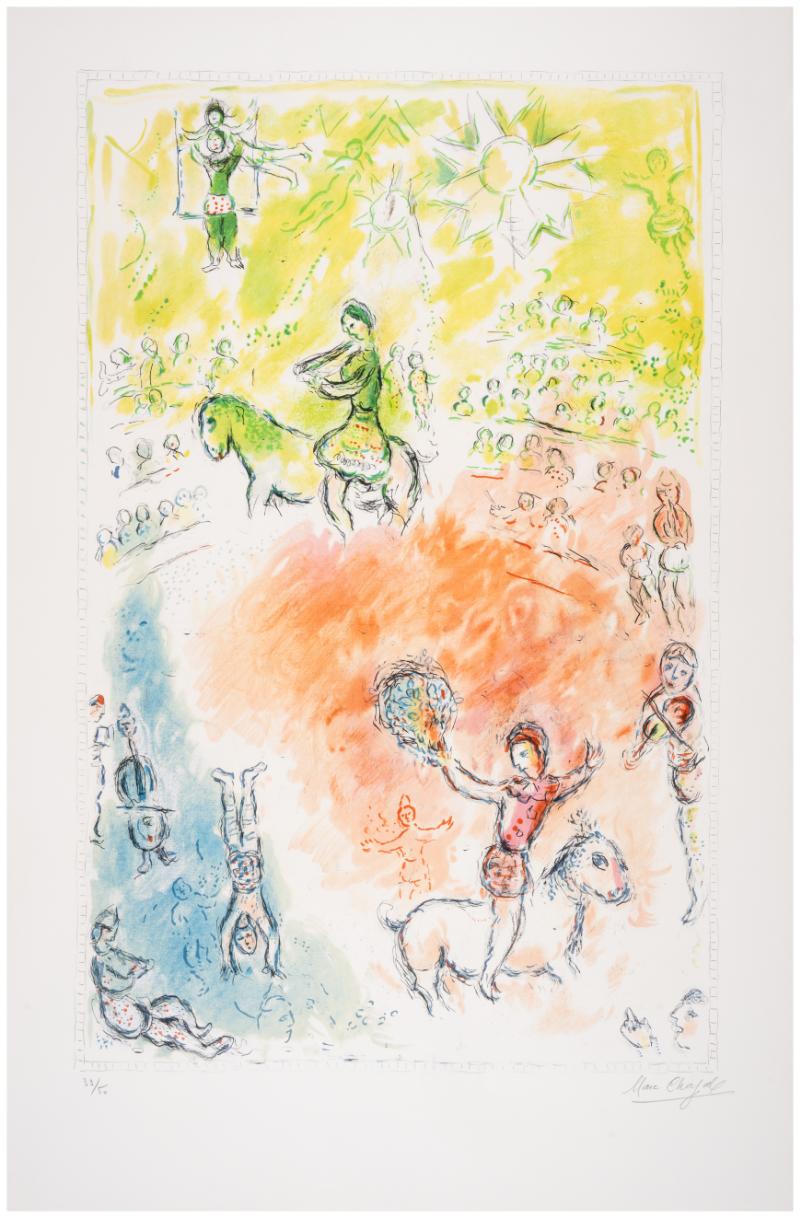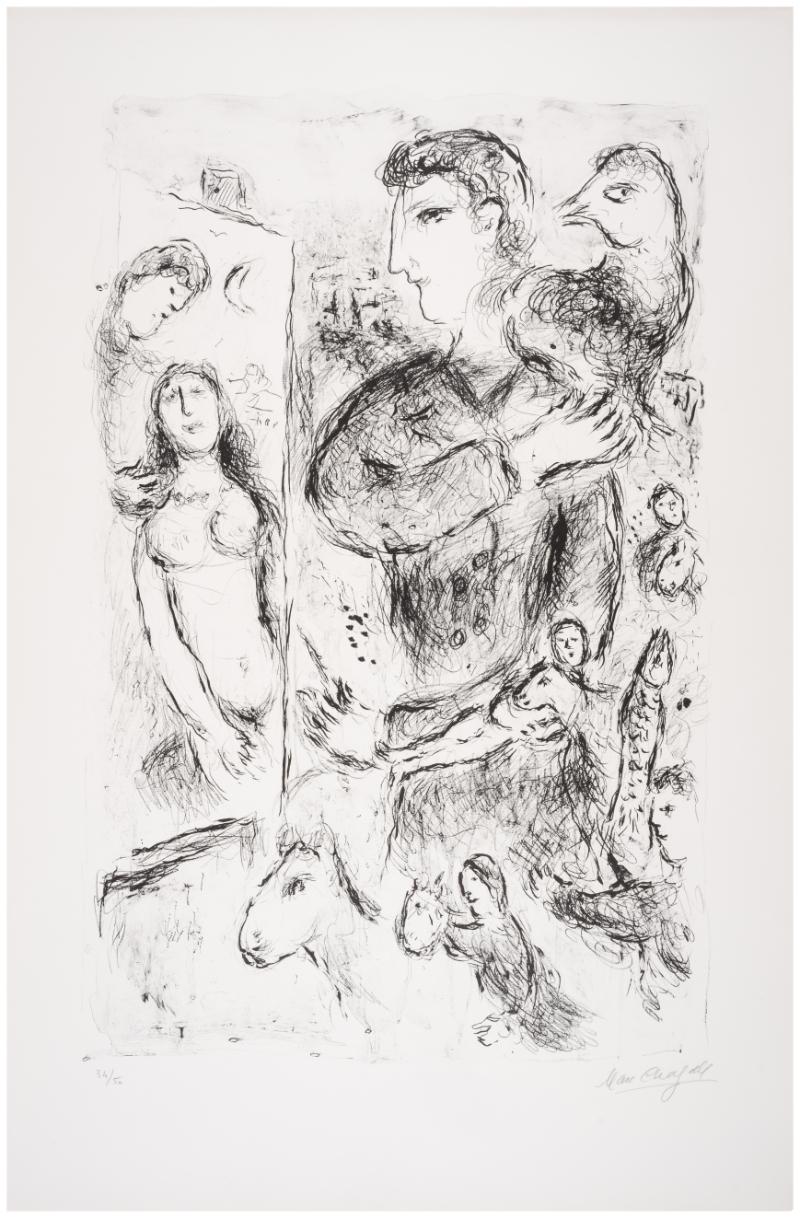Marc Chagall"Ruth Glaneuse (Ruth Gleaning), " Original Color Lithograph by Marc Chagall1960
1960
About the Item
- Creator:Marc Chagall (1887 - 1985, French)
- Creation Year:1960
- Dimensions:Height: 25.5 in (64.77 cm)Width: 21.5 in (54.61 cm)
- Medium:
- Movement & Style:
- Period:
- Condition:
- Gallery Location:Milwaukee, WI
- Reference Number:
Marc Chagall
Described by art critic Robert Hughes as "the quintessential Jewish artist of the twentieth century," the Russian-French modernist Marc Chagall worked in nearly every artistic medium. Influenced by Symbolism, Fauvism, Cubism and Surrealism, he developed his own distinctive style, combining avant-garde techniques and motifs with elements drawn from Eastern European Jewish folk art.
Born Moishe Segal in 1887, in Belarus (then part of the Russian empire), Chagall is often celebrated for his figurative paintings, but he also produced stained-glass windows for the cathedrals of Reims and Metz, in France; for the United Nations, in New York; and for the Hadassah Hospital in Jerusalem, as well as book illustrations, stage sets, ceramics, tapestries and fine-art prints. Characterized by a bold color palette and whimsical imagery, his works are often narrative, depicting small-village scenes and quotidian moments of peasant life, as in his late painting The Flight into Egypt from 1980.
Before World War I, Chagall traveled between St. Petersburg, Paris and Berlin. When the conflict broke out, he returned to Soviet-occupied Belarus, where he founded the Vitebsk Arts College before leaving again for Paris in 1922. He fled to the United States during World War II but in 1947 returned to France, where he spent the rest of his life. His peripatetic career left its mark on his style, which was distinctly international, incorporating elements from each of the cultures he experienced.
Marc Chagall remains one of the past century’s most respected talents — find his art on 1stDibs.
- ShippingRetrieving quote...Ships From: Milwaukee, WI
- Return PolicyA return for this item may be initiated within 14 days of delivery.
- "La Grande Guerre (The Great War), " Color Lithograph after Rene MagritteBy René MagritteLocated in Milwaukee, WI"La Grande Guerre (The Great War)" is a color lithograph after the 1964 painting by Rene Magritte. A Victorian lady stands in white facing the viewer. A bouq...Category
2010s Surrealist Figurative Prints
MaterialsLithograph
- 20th century color lithograph three women figures red sun plants animalBy Marc ChagallLocated in Milwaukee, WI"Noémie et ses Belles-Filles (Naomi and her Daughters-in-law), M 245/268" is an original Lithograph by Marc Chagall. This original color lithograph was designed for and printed by VE...Category
1960s Surrealist Figurative Prints
MaterialsLithograph
- 20th century color lithograph nude female figure landscape expressionist lineBy André MassonLocated in Milwaukee, WI"Dalila" is an original color lithograph by Andre Masson. This piece, which features an abstract, surreal woman, is from Masson's "Je Reve (I Dream)" por...Category
1970s Surrealist Figurative Prints
MaterialsLithograph
- "Front Cover of "Chagall Lithographe III, " M 577, " Original Color LithographBy Marc ChagallLocated in Milwaukee, WI"Front Cover of "Chagall Lithographe III," M 577" is an original Lithograph by Marc Chagall. This painting is primarily red with black lines defining the figures and objects. Followi...Category
1960s Surrealist Figurative Prints
MaterialsLithograph
- "La Page Blanche (The White Page)" lithograph after painting by Rene MagritteBy René MagritteLocated in Milwaukee, WI"La Page Blanche," or in English "The White Page," is an original color lithograph executed after the original painting from 1967 by the Belgian Surrealist...Category
2010s Surrealist Figurative Prints
MaterialsLithograph
- "La race blanche (The White Race), " Lithograph after Painting by Rene MagritteBy René MagritteLocated in Milwaukee, WI"La race blanche (The White Race)" is a color lithograph after the original 1937 painting by Rene Magritte. A female figure is made out of a mix of body parts. An eye sits on top of an ear, which is on top of a mouth, then two noses. Two breasts lying on a stomach; two arms come from the breasts. Legs are tucked under the stomach. This figure is on a sand dune next to the ocean. Art: 26.5 x 19.63 in Frame: 40.88 x 33.88 in René-François-Ghislain Magritte was born November 21, 1898, in Lessines, Belgium and died on August 15, 1967 in Brussels. He is one of the most important surrealist artists. Through his art, Magritte creates humor and mystery with juxtapositions and shocking irregularities. Some of his hallmark motifs include the bourgeois “little man,” bowler hats, apples, hidden faces, and contradictory texts. René Magritte’s father was a tailor and his mother was a miller. Tragedy struck Magritte’s life when his mother committed suicide when he was only fourteen. Magritte and his two brothers were thereafter raised by their grandmother. Magritte studied at the Brussels Academy of Fine Arts from 1916 to 1918. After graduating he worked as a wallpaper designer and in advertisement. It was during this period that he married Georgette Berger, whom he had known since they were teenagers. In 1926, René Magritte signed...Category
Early 2000s Surrealist Figurative Prints
MaterialsLithograph
- Iesu Transfigurato - Lithography - 1964By Salvador DalíLocated in Roma, ITIesu Transfigurato is a Color lithograph on heavy rag paper realized in 1964. It is part of Biblia Sacra vulgatæ edition is published by Rizzoli-Mediolani between 1967 and 1969. Si...Category
1960s Surrealist Figurative Prints
MaterialsLithograph
- Le Bouquet RoseBy Marc ChagallLocated in London, GBLithograph in colours, 1980, on Arches paper, signed in pencil, numbered from the edition of 50, published by Maeght Editeur, Paris, image: 94 x 69.9 cm. (37 x 23 ½ in.), sheet: 116....Category
1980s Surrealist Figurative Prints
MaterialsLithograph
- Les Amoureux à l'IsbaBy Marc ChagallLocated in London, GBLithograph in colours, 1980, on Arches paper, signed in pencil, numbered from the edition of 50, published by Maeght Editeur, Paris, image: 60 x 94.3 cm. (23 5/8 x 37 1/8 in.), sheet...Category
1980s Surrealist Figurative Prints
MaterialsLithograph
- Les Clowns MusiciensBy Marc ChagallLocated in London, GBLithograph in colours, 1980, on Arches paper, signed in pencil, numbered from the edition of 50, published by Maeght Editeur, Paris, image: 95.3 x 60.4 cm. (37 ½ x 23 ¾ in.), sheet: ...Category
1980s Surrealist Figurative Prints
MaterialsLithograph
- La ParadeBy Marc ChagallLocated in London, GBLithograph in colours, 1980, on Arches paper, signed in pencil, numbered from the edition of 50, published by Maeght Editeur, Paris, image: 95.9 x 61.6 cm. (37 ¾ x 24 ¼ in.), sheet: ...Category
1980s Surrealist Figurative Prints
MaterialsLithograph
- CréationBy Marc ChagallLocated in London, GBLithograph, 1980, on Arches paper, signed in pencil, numbered from the edition of 50, published by Maeght Editeur, Paris, image: 94 x 69.9 cm. (37 x 23 ½ in), sheet: 118.8 x 75.6 cm....Category
1980s Surrealist Figurative Prints
MaterialsLithograph
